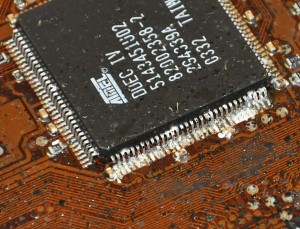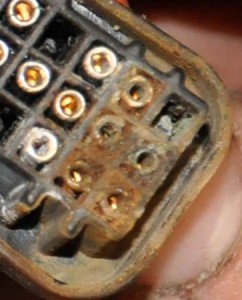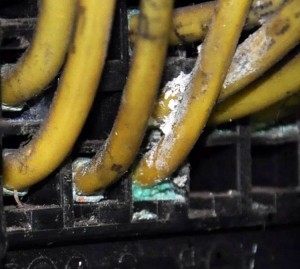 We see some unusual electrical problems every day in our engineering center. These types of problems cannot be fixed over the phone, so the truck must come to our shop for repair. One particular Cat-powered Freightliner Classic, which recently came in to our shop, had an interesting issue – it would not shut off! The 2002 Freightliner Classic with a 6NZ Caterpillar continued to idle indefinitely after the key was removed from the ignition. The only way to shut the truck down was to stall it or remove the battery terminal.
We see some unusual electrical problems every day in our engineering center. These types of problems cannot be fixed over the phone, so the truck must come to our shop for repair. One particular Cat-powered Freightliner Classic, which recently came in to our shop, had an interesting issue – it would not shut off! The 2002 Freightliner Classic with a 6NZ Caterpillar continued to idle indefinitely after the key was removed from the ignition. The only way to shut the truck down was to stall it or remove the battery terminal.
The first occurrence of this problem happened two weeks prior to the owner bringing the truck in. The owner operator had taken the truck to a local dealer who had replaced the ignition switch, but failed to fix the problem. The mechanic told the owner operator that they could not fix the problem and that they “Didn’t read any codes.” They sent him away with a bill – and a truck that would still not shut down.
 When the truck pulled into our shop, the problem was actively occurring, making it easier to diagnose. Intermittent problems are the hardest to find, so I was happy to see the complaint firsthand. The first thing I attempted to do was check to see if the ECM was powered. The fastest way to do this is though the datalink – too bad the datalink underneath the key switch was full of corrosion. As soon as I tried to connect to the pins, they turned to dust. Every datalink connector that I have ever seen like this was capped, but it had a water intrusion problem. Those caps are good for keeping dust and water out unless the water is coming from the back of the connector, then the caps are good for keeping water in, not out! Anyone who has a water intrusion problem must keep those caps off so the pins aren’t constantly being dissolved in a pool of water (we keep lots of those pins in stock for this very reason). The mechanic was right when he said that they didn’t read any codes, because they couldn’t read any codes! Without a datalink connection, you have no connection to the other computers in the truck, and are completely blind as to what they are doing!
When the truck pulled into our shop, the problem was actively occurring, making it easier to diagnose. Intermittent problems are the hardest to find, so I was happy to see the complaint firsthand. The first thing I attempted to do was check to see if the ECM was powered. The fastest way to do this is though the datalink – too bad the datalink underneath the key switch was full of corrosion. As soon as I tried to connect to the pins, they turned to dust. Every datalink connector that I have ever seen like this was capped, but it had a water intrusion problem. Those caps are good for keeping dust and water out unless the water is coming from the back of the connector, then the caps are good for keeping water in, not out! Anyone who has a water intrusion problem must keep those caps off so the pins aren’t constantly being dissolved in a pool of water (we keep lots of those pins in stock for this very reason). The mechanic was right when he said that they didn’t read any codes, because they couldn’t read any codes! Without a datalink connection, you have no connection to the other computers in the truck, and are completely blind as to what they are doing!
After the datalink was repaired, it was clear that the ECM was not shutting down. After tracing out the circuit, it was evident that the ignition circuit pin on the firewall was supplying voltage – even if the ignition key switch was removed. This problem was clearly on the cab side of the firewall. The ECM will not shut down until voltage from the ignition is no longer supplied or engine rpm is reduced below cranking rpm (stalling). After completely removing the ignition key switch from the dashboard, the next stop was the power distribution panel and the relays. This Freightliner did not have fuses, but instead had circuit breakers, which made isolating the involved circuits more time-consuming. As it turned out, multiple circuits were involved, and the further we dug into this problem, the more corrosion we found. The truck had plastic bags for windows in the sleeper, so that should have been a clue that this truck had some water intrusion problems.
 As a power distribution panel corrodes due to water intrusion, circuits will fail. Sometimes, the corrosion grows to the point where it will act as a bridge to a neighboring circuit and ends up sending voltage somewhere it isn’t supposed to go. In this case, corrosion had built a good enough bridge to send 11 volts from the trailer option circuit to the ignition circuit! After the truck ignition switch was turned on, the switched power circuit would energize. The switched power circuit would then energize a whole bank of other circuits, of which one of those circuits had enough corrosion to build a bridge back to the ignition circuit. Now, the ignition key circuit was bypassed and the ignition circuit to the ECM ended up creating a self-sustaining loop. This is why the key would no longer shut the truck down. After nine hours of work, several feet of wire, and the replacement of eight bad relays, the immediate problem was fixed. The owner was advised to address the water intrusion problem as soon as possible, because this problem will happen again if more water enters the dashboard.
As a power distribution panel corrodes due to water intrusion, circuits will fail. Sometimes, the corrosion grows to the point where it will act as a bridge to a neighboring circuit and ends up sending voltage somewhere it isn’t supposed to go. In this case, corrosion had built a good enough bridge to send 11 volts from the trailer option circuit to the ignition circuit! After the truck ignition switch was turned on, the switched power circuit would energize. The switched power circuit would then energize a whole bank of other circuits, of which one of those circuits had enough corrosion to build a bridge back to the ignition circuit. Now, the ignition key circuit was bypassed and the ignition circuit to the ECM ended up creating a self-sustaining loop. This is why the key would no longer shut the truck down. After nine hours of work, several feet of wire, and the replacement of eight bad relays, the immediate problem was fixed. The owner was advised to address the water intrusion problem as soon as possible, because this problem will happen again if more water enters the dashboard.
Beware of any “truck stop programmer” who tries to prey upon you! There are a few frustrated mechanics hanging around truck stops (one in particular drives a BMW and wears a suit) advertising that they can reprogram your ECM and improve your fuel mileage and performance. What they are doing is maxing out the injectors, thus taking the injector out of calibration. Most all electronic injectors have a number printed on them which tells how much fuel that particular injector injects. When the injectors are changed in the engine, those injector numbers are then put into the ECM to regulate how much fuel the injector receives to balance out the power. Then, along comes someone with a laptop and all they can do is go into the ECM and max out all of the injectors, which screws up all of the flow rates. Yes, the engine will gain some power, but it will not be smooth power and, usually, the idle ends up being rough. This is not the proper way to improve the performance of the ECM or the engine.
 Please think about what could happen to your engine by allowing a “parking lot programmer” who is living out of his van or a hotel room mess with the most critical computer on your engine. It has also come to our attention that some of these individuals are claiming to be affiliated with Pittsburgh Power, Inc. This is ABSOLUTELY NOT TRUE. We do not have ANY employees working out of truck stop parking lots. If you have any comments or questions, please contact me through Pittsburgh Power Inc. in Saxonburg, PA at (724) 360-4080 or via e-mail at bruce@pittsburghpower.com.
Please think about what could happen to your engine by allowing a “parking lot programmer” who is living out of his van or a hotel room mess with the most critical computer on your engine. It has also come to our attention that some of these individuals are claiming to be affiliated with Pittsburgh Power, Inc. This is ABSOLUTELY NOT TRUE. We do not have ANY employees working out of truck stop parking lots. If you have any comments or questions, please contact me through Pittsburgh Power Inc. in Saxonburg, PA at (724) 360-4080 or via e-mail at bruce@pittsburghpower.com.
